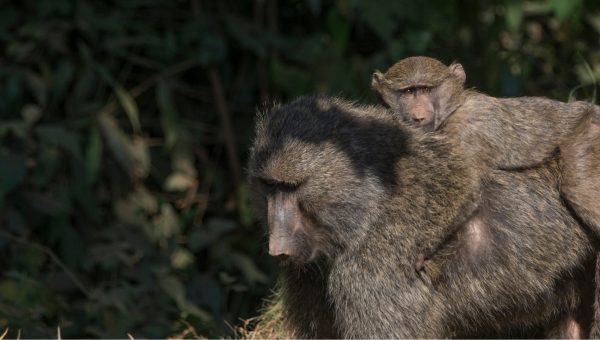02
Jun
Scientists Identify 97 Pesticides and Chemical Pollutants in Study of Primate Population

(Beyond Pesticides, June 2, 2023) Scientists have identified 97 different types of pesticides and flame retardants in primate fecal samples, recently reporting their results in the journal Biology Letters. In Uganda’s Kibale National Park, researchers studied the chemical exposure of four species of primates (chimpanzees, Ugandan red colobus, olive baboons and red-tailed monkeys), adding to previous research on the subject. The chemicals demonstrate a measurable effect on primate growth and development, sparking considerable unease as to the future health of these critical species. This study shows how even within a protected national park, wildlife species are at risk from chemical pollution. According to advocates, the use of dangerous pesticides and flame retardants, therefore, must be entirely stopped in order to protect the future viability of wildlife species.
Scientists collected a total of 71 fecal samples from the four chosen species to measure levels of chemicals and hormones in a noninvasive manner. After sample analysis, researchers highlight three main groups of chemical pollutants: organochlorine pesticides (OCPs), brominated flame retardants (BFRs), and organophosphate esters (OPEs). Although in a protected area, wildlife species encounter humans through tourism, research, and human development surrounding the park. As these pesticides are so prevalent in areas of development, humans entering the park often carry with them harmful chemical residues. The researchers speculate the animals are most often exposed to harmful chemicals through ingestion of crops surrounding the park, inhalation of airborne contaminants originating from surrounding farmland, and ingestion of pollutants within the park itself.
Analysis determined that juvenile and adult female primates are most negatively affected by chemical exposure. Higher concentrations of the chemicals studied correspond to altered levels of the stress hormone cortisol, as well as the sex hormone estradiol. Both of these hormones play an essential role in the health of an individual. Exposure to one BFR is especially consistent across the samples, showing up in more than 70% of the population studied. Previous research focused on BFRs has found that, when exposed early in development, mice are ill-equipped to effectively excrete the harmful chemicals, leading to accumulation over an animal’s lifespan. As mice and primates are both mammals, similar patterns of accumulation may explain the consistent concentrations of BFRs in the sample population.
Pesticides and flame retardants pose a significant threat to the future health of primate populations, as these chemicals are particularly known for their ability to alter hormone production. The altered hormone levels resulting from chemical exposure signal significant dysfunction of the endocrine system, which controls the production and regulation of hormones within organisms. The endocrine system is essential for healthy metabolism, growth, and reproduction, as these processes are initiated and blocked by hormones. Given the rapid growth experienced by juveniles, the importance of a properly functioning endocrine system is heightened during these critical stages of development. Chemical exposure during these early phases of life leaves younger organisms especially vulnerable to lasting negative health outcomes.
As the study states, “Whereas activational effects of endocrine disruptors in adult primates are expected to be relatively more transient, disruption of steroid hormones in juveniles during development can result in permanent phenotypic changes in morphological, physiological and behavioural structure and function.” In other words, adults are better equipped to maintain normal functioning in response to chemical exposure, and the health impacts are often temporary. Juveniles, however, are more susceptible to lasting, and sometimes even permanent, damage.
The increased impact of chemical exposure on females and juveniles, as presented in the study, demonstrates the particular danger posed to critical stages of female reproduction and the resulting growth of their offspring. Existing studies highlight how mothers can transfer significant concentrations of chemicals to their offspring during pregnancy, as well as during lactation and nursing: perhaps explaining the heightened vulnerabilities of the young primates studied.
Although research on endocrine disruptors continuously links these chemicals to negative health effects, such as infertility, diabetes, Parkinson’s, obesity, cancers, cardiovascular disease, and Alzheimer’s, the EPA has failed to devote adequate resources to the evaluation and testing of endocrine-disrupting chemicals present in pesticides, despite a mandate incorporated way back in 1996 in the Food Quality Protection Act. As exposure to these harmful pesticides clearly leads to impaired growth and reproduction, advocates have repeatedly called for a stop to the unleashing of such dangerous concoctions of chemicals in an effort to eliminate this cycle of damaged development.
Pesticide use does not exist in a vacuum. Once applied, a pesticide’s pathway through the environment cannot be reliably contained. The chemicals cycle through soil and water systems, posing threats to humans and wildlife far from the initial source. For more information on the destructive effects of pesticides on such an interconnected environment, check out Beyond Pesticides’ resource page on how pesticides affect wildlife, and check out the wildlife section of our Pesticide-Induced Diseases Database. While you’re at it, take action to help endangered species impacted by pesticide contamination and fight to ban these toxic chemicals from entering the environment in the first place.
All unattributed positions and opinions in this piece are those of Beyond Pesticides.
Sources: Biology Letters; Natural History Museum










